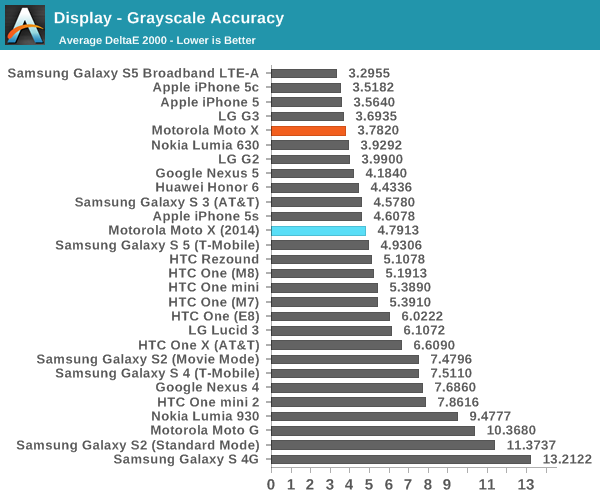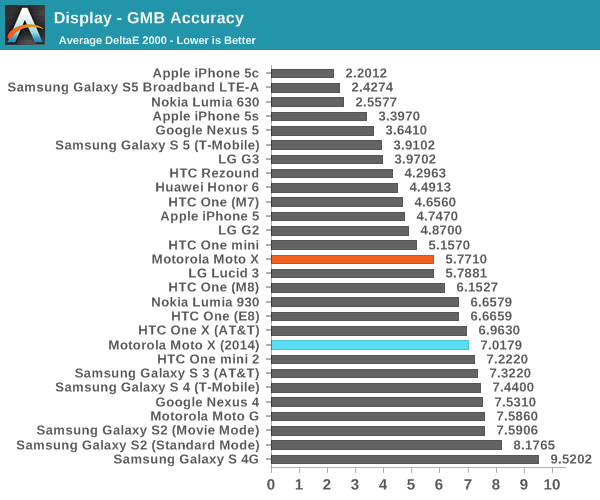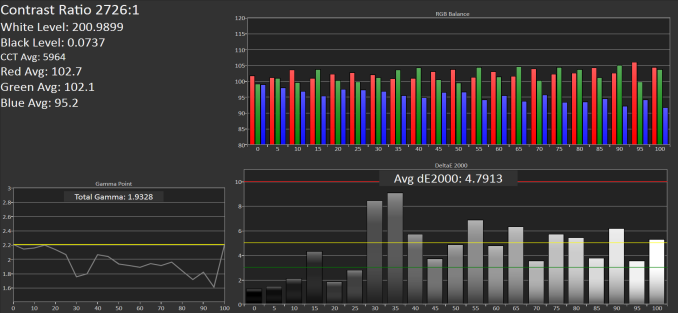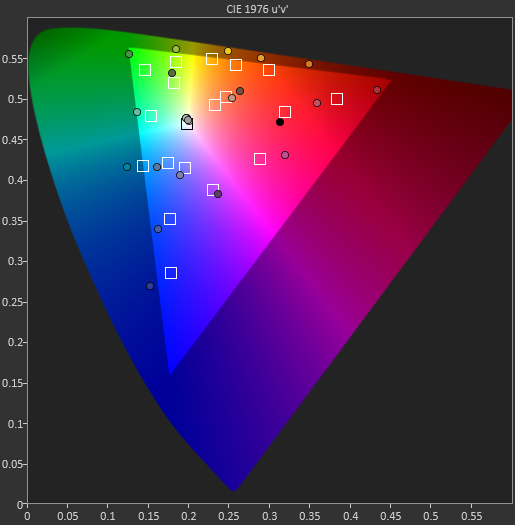The New Motorola Moto X (2nd Gen) Review
by Joshua Ho on September 17, 2014 9:00 AM EST- Posted in
- Smartphones
- Motorola
- Android
- Mobile
Display
Without question, the display is one of the most important aspects of a smartphone. Unlike desktops and laptops, smartphones are primarily interacted with through their displays. Unfortunately, it’s hard to evaluate a display by eye as human vision is strongly dependent upon context. In order to control for this aspect, we turn to SpectraCal’s CalMAN 5 with a custom workflow in order to test smartphone displays. At any rate, let’s get into the data.

In the basics, the new Moto X is a bit on the low side. While AMOLED has traditionally struggled with luminance in situations such as the web browser and light-themed applications, Samsung’s Galaxy S5 and S5 LTE-A Broadband have shown that it’s possible to achieve levels of brightness approaching some of the brightest RGB-stripe LCDs. As the brightness of the Lumia 930 is about equal to the new Moto X, I suspect we're looking at the Galaxy S4/Note 3 generation of panels. This seems to be backed up by pictures of the subpixel layout seen below as the green subpixels seem to be noticeably larger when compared to the Galaxy S5's panel.
Contrast is still incredible, but I can still see the purple smearing effect that comes from unlit to lit pixels. I’m still unable to get a clear answer on why this is, but it’s likely that capacitance somewhere in the system is causing this issue in the form of RC delay. Whether this is a fixable issue is something I’m not aware of yet. The clear solution would be to set black to the lowest possible brightness a lit pixel can be, but this would make for worse contrast.


In grayscale, the new Moto X isn’t the best. We see that the display is just a bit too red, and that most of the luminance is coming from red and green. This makes sense from a power and display lifetime perspective though, as blue tends to have the least efficient emitter material in an AMOLED display. However, this translates to poor grayscale performance. The green tint tends to show itself in certain shades of grayscale as well.

In our saturation sweep, the new Moto X continues to be rather poor in its performance. While on Samsung phones it’s normal to see colors like this on the default display mode, there’s usually a mode that correctly constrains the display to sRGB which is the industry standard for displaying colors. There’s no such mode on the new Moto X, so the display significantly overshoots sRGB. This doesn’t bode well for the ColorChecker, which provides the most thorough look at color accuracy.

As predicted, the new Moto X does poorly in the ColorChecker. There’s really not much that the Moto X can accurately display in sRGB as just by pushing the gamut too far, even if there wasn’t saturation compression for some colors, the large gamut will cause distortion of all colors within the gamut triangle.
Unfortunately, it’s not clear where this lack of attention to color accuracy comes from. In discussions with Andrei it's clearly possible to calibrate the AMOLED panel from the GS4 quite accurately, and there's no real technical limitation for AMOLED to lack good calibration. However, judging by the relatively low peak brightness there are other issues as this could affect Motorola's performance in battery life tests. This seems to suggest that Motorola is unable to access the latest generation of AMOLED panels from Samsung Display.
This would be a rather startling thought, as it means that no matter what Motorola does to improve their implementation of Samsung’s AMOLED displays, they will always be behind the curve. If it becomes clear that Samsung’s AMOLED is the best display from a user-facing standpoint, every other OEM will face significant barriers in competition as they would be unable to access the latest generation AMOLED panels. The real solution here is for other display manufacturers such as LG, JDI, and AUO Optronics to catch up.
At any rate, the display of the new Moto X seems to be relatively poor compared to what we see in the Galaxy S5 LTE-A (and likely the Note 4), along with the iPhone 5s, Nexus 5, and One (M7). While it’s impossible to ignore the power advantage of AMOLED when implementing functions like Moto Display, the relatively low peak brightness and poor color accuracy are concerning.















179 Comments
View All Comments
cknobman - Wednesday, September 17, 2014 - link
Hmmm.........Crap screen
Crap battery life
Crap camera
Why should anyone buy this again?
piroroadkill - Wednesday, September 17, 2014 - link
They won't.There were reasons to buy Moto X, but this new version is pointless, it's huge and worse than the alternatives.
soccerballtux - Thursday, September 18, 2014 - link
I don't understand what the hate is. I still think it's a great phone.gg555 - Wednesday, September 24, 2014 - link
I'd say it has a very good, but not top of the line screen. A passable camera. And okay battery life (bettery than many of last years phones), but again not top of the line for today's flagships. So your characterizations are unfair, I think.The Moto X does have a beautiful design, arguably one of the best out there, on a Par with the HTC One M8. It also has the active display, always on voice commands, and the hand gestures, which sound like they are very well developed features that add convenience (unlike the gimmicky heartrate crap on other phones).
It has basically stock Android, without a bunch of bloat software, which many people like. And this will also make it easy for it to get very quick updates to new version of the OS (all of Motorola's additions are downloadable as apps and do not require Motorola to spend a lot of time updating its skin, etc., for a new version of Android).
It also as a super sophisticated antenna design, as explained in the AnandTech preview of the phone a couple weeks ago. That ought to make it industry leading, if you know, you use your phone to connect to a network.
And it has a once of a kind four microphone noise cancellation solution. This is extremely unusual. The best noise cancellation chip out their (from Audience) has a three microphone option, but don't know of anyone who has even implemented that (if so it's very rare). Two microphones is the norm. So four microphones is exception. Unfortunately, AnandTech did not test it like they used to do. But it could make for incredible call clarity in noisy settings.
So the Moto X is certainly not necessarily for everyone. There are arguments to be made for other phones. But I think it holds it own, offers useable features, rather than gimmicks, and has a lower price than other flagships. It's a prefectly good choice. Other phones have their own shortcomings.
DeciusStrabo - Wednesday, September 17, 2014 - link
Man, that's sad to see all these regressions. I love my Moto X, could easily deal with the increased size and love to see the performance, but that battery life is simply embarassing. Worse than last years version? That's simply not acceptable. Worse screen in some respects and a camera that's somewhat better, but not really good doesn't help.I really was very close to ordering the new Moto X, but it seems I will have to wait at least until the new Nexus device, maybe even longer. Or - god forbid - think about an iPhone.
semo - Wednesday, September 17, 2014 - link
In this day and age, regression sells! I have no idea how but putting taking useful features away somehow generates more sales. It's also another chance to (re)introduce groundbreaking and amazing features at a later date!I think these days, if you are a phone manufacturer, all you have to do is make the screen bigger and you can take a massive dump on anything else. Better still, if you are a monitor manufacturer, just stick an LTE chip to one of your monitors and sell it as the best phone ever.
MrGutts - Wednesday, September 17, 2014 - link
Not to be a smart ass; well yeah I am going to be.Why in the world does someone want to invest money in a company that gets pass around like some prostitute on Saturday night? Who's turn is it this year, IBM was it?
The company doesn't communicate anything to the consumers, they horribly screwed a ton of customers on new phones telling them they are NOT upgrading the android OS on the phones. The list can go on with them.
DeciusStrabo - Wednesday, September 17, 2014 - link
Which phones don't get an update by Motorola?soccerballtux - Thursday, September 18, 2014 - link
The Atrix4G was marketed as the worlds most powerful phone, and never made it past Gingerbread even with its 1GB RAM and dual core processor.I still hate them for it
randomlinh - Wednesday, September 17, 2014 - link
Hrm, no T-Mobile LTE band 12... which is the newly acquired 700mhz VZW band I believe? Though, almost moot given how disappointing the battery life is.